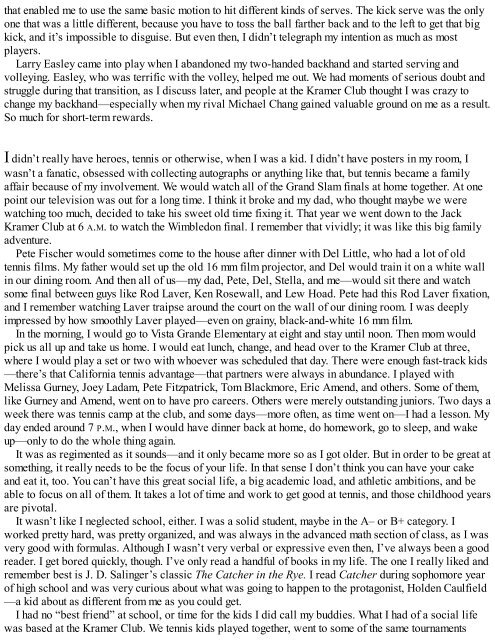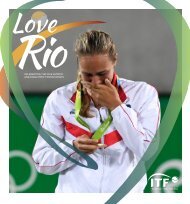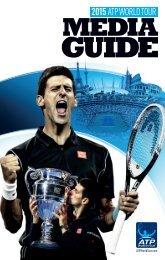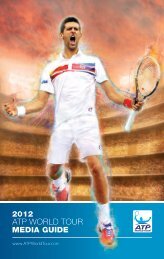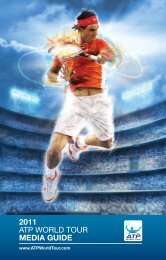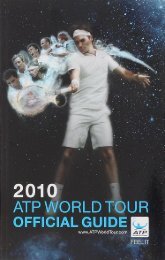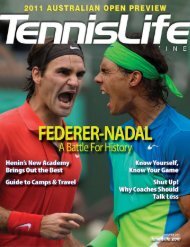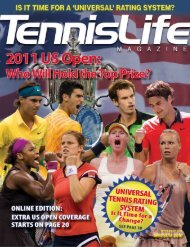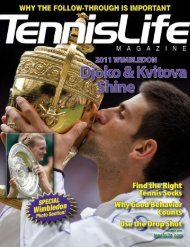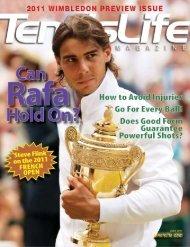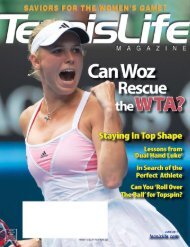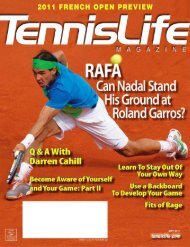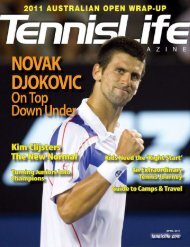A Champion's Mind - Pete Sampras
www.tennismoscow.me Insta:TENNISMOSCOW
www.tennismoscow.me Insta:TENNISMOSCOW
Create successful ePaper yourself
Turn your PDF publications into a flip-book with our unique Google optimized e-Paper software.
that enabled me to use the same basic motion to hit different kinds of serves. The kick serve was the only<br />
one that was a little different, because you have to toss the ball farther back and to the left to get that big<br />
kick, and it’s impossible to disguise. But even then, I didn’t telegraph my intention as much as most<br />
players.<br />
Larry Easley came into play when I abandoned my two-handed backhand and started serving and<br />
volleying. Easley, who was terrific with the volley, helped me out. We had moments of serious doubt and<br />
struggle during that transition, as I discuss later, and people at the Kramer Club thought I was crazy to<br />
change my backhand—especially when my rival Michael Chang gained valuable ground on me as a result.<br />
So much for short-term rewards.<br />
I didn’t really have heroes, tennis or otherwise, when I was a kid. I didn’t have posters in my room, I<br />
wasn’t a fanatic, obsessed with collecting autographs or anything like that, but tennis became a family<br />
affair because of my involvement. We would watch all of the Grand Slam finals at home together. At one<br />
point our television was out for a long time. I think it broke and my dad, who thought maybe we were<br />
watching too much, decided to take his sweet old time fixing it. That year we went down to the Jack<br />
Kramer Club at 6 A.M. to watch the Wimbledon final. I remember that vividly; it was like this big family<br />
adventure.<br />
<strong>Pete</strong> Fischer would sometimes come to the house after dinner with Del Little, who had a lot of old<br />
tennis films. My father would set up the old 16 mm film projector, and Del would train it on a white wall<br />
in our dining room. And then all of us—my dad, <strong>Pete</strong>, Del, Stella, and me—would sit there and watch<br />
some final between guys like Rod Laver, Ken Rosewall, and Lew Hoad. <strong>Pete</strong> had this Rod Laver fixation,<br />
and I remember watching Laver traipse around the court on the wall of our dining room. I was deeply<br />
impressed by how smoothly Laver played—even on grainy, black-and-white 16 mm film.<br />
In the morning, I would go to Vista Grande Elementary at eight and stay until noon. Then mom would<br />
pick us all up and take us home. I would eat lunch, change, and head over to the Kramer Club at three,<br />
where I would play a set or two with whoever was scheduled that day. There were enough fast-track kids<br />
—there’s that California tennis advantage—that partners were always in abundance. I played with<br />
Melissa Gurney, Joey Ladam, <strong>Pete</strong> Fitzpatrick, Tom Blackmore, Eric Amend, and others. Some of them,<br />
like Gurney and Amend, went on to have pro careers. Others were merely outstanding juniors. Two days a<br />
week there was tennis camp at the club, and some days—more often, as time went on—I had a lesson. My<br />
day ended around 7 P.M., when I would have dinner back at home, do homework, go to sleep, and wake<br />
up—only to do the whole thing again.<br />
It was as regimented as it sounds—and it only became more so as I got older. But in order to be great at<br />
something, it really needs to be the focus of your life. In that sense I don’t think you can have your cake<br />
and eat it, too. You can’t have this great social life, a big academic load, and athletic ambitions, and be<br />
able to focus on all of them. It takes a lot of time and work to get good at tennis, and those childhood years<br />
are pivotal.<br />
It wasn’t like I neglected school, either. I was a solid student, maybe in the A– or B+ category. I<br />
worked pretty hard, was pretty organized, and was always in the advanced math section of class, as I was<br />
very good with formulas. Although I wasn’t very verbal or expressive even then, I’ve always been a good<br />
reader. I get bored quickly, though. I’ve only read a handful of books in my life. The one I really liked and<br />
remember best is J. D. Salinger’s classic The Catcher in the Rye. I read Catcher during sophomore year<br />
of high school and was very curious about what was going to happen to the protagonist, Holden Caulfield<br />
—a kid about as different from me as you could get.<br />
I had no “best friend” at school, or time for the kids I did call my buddies. What I had of a social life<br />
was based at the Kramer Club. We tennis kids played together, went to some of the same tournaments


